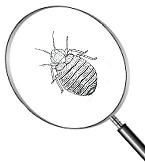Table of Contents [hide]
What we need to know about bed bugs
Bedbugs in apartments are a problem that is more and more frequent in Montreal. Anyone can have them, even without knowing! When a bedbug problem emerges, both landlords and tenants have obligations.
Bed bugs are brownish insects that can be seen with the naked eye since they are about 4 millimetres long. They are active and visible mostly at night, usually along the seams of mattresses. They feed on sleepers’ blood and so are generally found in bedrooms. During the day, bed bugs stay in dark, dry places such as cracks in walls, curtains, clothing, behind peeling wallpaper, baseboards or pictures, etc. However, when the infestation is large, they can be found elsewhere (dishes, cupboards, toys, etc.).
Bed bugs don’t jump or fly. They crawl at about the speed of ants. They usually are transported on fabrics, furniture and suitcases.
They are sensitive to extreme temperatures. They feed on human blood but can go without food for over a year, given the right temperature.
Bed bugs’ presence is detected by direct observation (on a person or mattress) or indirect observation (blood, excrement, bites). Bites itch, often seen in groups of three; they are red bumps with a tiny red point at the centre. The excrement is easy to see: black speckles on mattress or sofa seams. Their dead skin is often found on the bed during the moulting season, along with small bloodstains from the bites.
Bed bugs don’t transmit diseases and their presence does not have to be reported to the public health authorities. Their bites are usually harmless, although in serious cases they can cause skin problems and allergic reactions. The collateral damage, however, can be considerable: embarrassment, guilt, sleep loss, isolation.
What to do?
It is advisable for tenants to quickly notify their landlord or the municipal housing bureau for the latter to arrange and pay for an exterminator to come to the dwelling as soon as possible and see to it that the bed bugs are eliminated. Landlords cannot criticize tenants for having bed bugs, but tenants can be reproached for not having informed them of the situation. In most cases the rental board will order the landlord to pay the extermination costs.
Important: Don’t try to solve the problem without an exterminator
Most insecticides are ineffective and will just drive the bed bugs into other dwellings. They will also excite the bugs and hasten their reproduction, thereby causing the infestation to propagate faster.
Source: Clinique communautaire de Pointe-Saint-Charles
Identifying and controlling bedbugs
What you need to know about bedbugs
Recently, bedbugs have made a comeback in Montréal, like in most large cities on the planet.
Where do they live?
Bedbugs live mostly in bedrooms, where they feed on the blood of people who are sleeping.Bedbugs avoid light and hide mostly in the following places:
- Along the seams of mattresses and box springs
- In bed frames
- In cracks and crevices in walls, floors and furniture
- Behind pictures on walls
- Along baseboards
- Inside electrical outlets
- In any other object that provides a dark, narrow space where they can hide
A crack wide enough to fit the edge of a credit card can harbour bedbugs.
Bedbugs can take up residence in rich or poor, clean or dirty homes.
Unlike lice or other parasites, bedbugs don’t live on humans.
How do bedbugs move around?
Bedbugs are often transported from place to place in objects in which they are hiding. Bedbugs can use bags, backpacks, clothing, mattresses, furniture, bedding, laptop computers or even wheelchairs as means of transportation.
What are the health effects of bedbugs?
Bedbugs do not transmit diseases to humans.
Bites on the skin are the first clue that there are bedbugs in your home. Bedbugs bite especially the arms but all body parts exposed during the night are likely to get bitten.
Bedbug bites or lesions look like mosquito bites. They usually disappear within a few days. The bites can be very itchy. Scratching the bites can result in skin infections.
The main health problems caused by bedbugs are
- itchy skin rash (bites),
- sleep disturbances,
- anxiety, and
- social isolation.
What you need to know to get rid of bedbugs effectively
Notify the building owner or manager
An occupant must inform the owner or person in charge of pest control as soon as possible that there are bedbugs in the apartment.
Act quickly
Building owners or administrators are responsible for contacting qualified pest controllers (exterminator having a government-issued license) to find solutions to the problem.
Use effective control methods that are not harmful to health
Several control methods should be considered, not only the use of insecticides. Pest controllers should only use insecticides that have been approved for use against bedbugs. To limit health impacts on occupants, the use of insecticides should be kept to the minimum required. Treatments must be repeated until bedbugs have completely disappeared.
Cooperate
Without the cooperation of all parties concerned (occupants, building owners or administrators, and qualified pest controllers), it is difficult to effectively eliminate bedbugs in an apartment or building.
Source: Ville de Montréal, Agence de la santé et des Services Sociaux de Montréal.
For more information
- Flyer ‘Don’t let the bedbugs bite‘, including helpful tips for preventing and eliminating bedbugs and tenant’s, landlord and exterminator responsabilities
- GUIDE FOR BUILDING OWNERS, ADMINISTRATORS AND MANAGERS (Best ways to fight bedbug infestations and how to prevent infestations)
- For more information or to lodge a complaint, dial 311 (Town of Montréal)
- Régie du logement, Tél.: 514-873-2245
- The Clinic can help you with preventing or dealing with an infestation. Don’t hesitate to ask!


